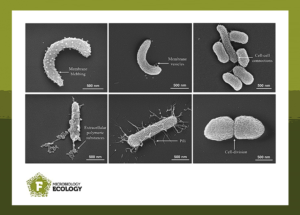Marine microbes play crucial roles in regulating global nutrient cycles. To adapt to the presence of nutrients, they adjust their metabolisms to balance cell growth and maintenance. Thus, they also adapt to seasonal changes, as discussed in the study “Prokaryotic Morphological Features and Maintenance Activities Governed by Seasonal Productivity Conditions” in FEMS Microbiology Ecology. In this #FEMSmicroBlog, Ashish Verma explains how marine microbes manage their resources under winter and summer conditions. #FascinatingMicrobes
Mimicking the open sea in experimental tanks
The morphology of cultured microbial isolates has been extensively studied. Yet, little is known about the natural morphology of microbes in marine ecosystems. It has long been thought that cell shapes and morphological features help microbes adapt and survive in the complex marine ecosystem.
To close this knowledge gap, the study “Prokaryotic Morphological Features and Maintenance Activities Governed by Seasonal Productivity Conditions” in FEMS Microbiology Ecology mimicked variations in one of Europe’s most advanced indoor mesocosm platforms. The goal was to analyze the morphological variations and metabolic activities of marine microbes in response to seasonal shifts.
The experimental setup contained insulated black polyethylene tanks measuring 5 meters in height and 0.75 meters in diameter and holding 2000 liters of seawater. These systems mimic realistic field conditions in a controlled environment, thus enabling researchers to precisely manage and test factors such as temperature, light, water mixing, and other key environmental variables.
Over a 27-day period in April 2020, temperature and nutrient levels were manipulated according to the seasonal variations of the northwestern Bothnian Sea, a Baltic sub-basin located between Sweden and Finland.
Unique morphologies help microbes adapt
At two sampling days midway through the experiment, seawater samples were collected from the mesocosms to analyze the microbial content and their morphological features. The features were analyzed using high-resolution scanning electron microscopy.
During both winter and summer conditions, microbes were primarily composed of two cell shapes: rods and vibrioids (curved rods). However, their distribution varied seasonally, with rod-shaped cells being more prevalent during winter and vibrioid cells more abundant during summer.
Using electron micrographs, six distinct morphological features were identified. These were: membrane blebbing, membrane vesicles, cell-cell connections, extracellular polymeric substances, pili, and cell division.

Three of these features, membrane blebbing, cell-cell connections, and membrane vesicles, were significantly more prevalent during summer. These structures facilitate cell migration, organic carbon transfer, and defense mechanisms, thus likely enhancing cellular interactions and survival.
In contrast, winter conditions did not favor the development of morphological traits. These results suggest that during this period, microbes focus on conserving energy for maintenance activities rather than structural adaptations.
Metatranscriptomics validate morphological and metabolic insights in microbes
The study further explored the genetic basis of seasonal adaptations through metatranscriptomics, examining gene expression. At the functional taxonomy level, archaeal phyla Asgardarchaeota and Thermoproteota dominated gene expression during winter conditions, while the bacterial phylum Pseudomonadota predominated the expression during summer conditions.
During summer conditions, genes associated with cell-cell connections, pili, and membrane vesicles showed higher expression levels than during winter conditions. These results support the morphological features observed under the microscope.
Maintenance metabolism genes related to defense, stress, and transporters were also expressed but at lower levels. It seems that even in growth-focused conditions, these processes remain essential.
During winter conditions, no genes linked to specific morphological features were prominently expressed. Yet, several maintenance-related genes were active. These included genes involved in signal transduction, osmoregulation, ribosome biogenesis, transporters, and cold stress, all of which help cells adapt to the cold and low productive ecosystems.
Together, this study provides valuable insights into how marine microbes adapt to seasonal changes by linking microbial morphological features to their genetic potential. The findings highlight the significance of microbial morphology during summer and underline the role of metabolic maintenance during winter conditions.
This knowledge could help us predict how marine microbes respond to environmental changes. Such predictions become especially important when considering the global impacts of climate change.
- Read the article “Prokaryotic Morphological Features and Maintenance Activities Governed by Seasonal Productivity Conditions” by Verma et al. in FEMS Microbiology Ecology (2024).

Ashish Verma is a postdoctoral fellow in the Department of Ecology and Environmental Science at Umeå University, Sweden. He holds a Ph.D. in Environmental Microbiology from the CSIR-Institute of Microbial Technology, Chandigarh, India. His research focuses on exploring the role and significance of microbes under varying climatic and environmental conditions. Ashish conducts experiments on natural microbial communities, employing a combination of classical rate measurements, advanced electron microscopy, and omics techniques. His work primarily investigates sub-Arctic and Arctic ecosystems, shedding light on microbial dynamics in these extreme environments.
About this blog section
The section #FascinatingMicrobes for the #FEMSmicroBlog explains the science behind a paper and highlights the significance and broader context of a recent finding. One of the main goals is to share the fascinating spectrum of microbes across all fields of microbiology.
| Do you want to be a guest contributor? |
| The #FEMSmicroBlog welcomes external bloggers, writers and SciComm enthusiasts. Get in touch if you want to share your idea for a blog entry with us! |
